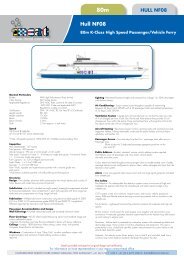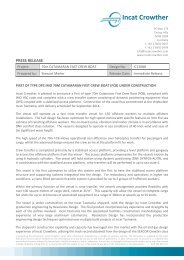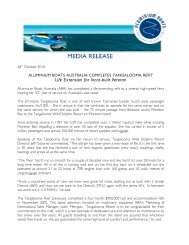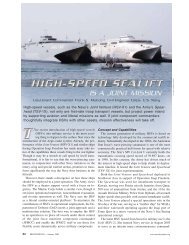US NAVY'S - Incat
US NAVY'S - Incat
US NAVY'S - Incat
You also want an ePaper? Increase the reach of your titles
YUMPU automatically turns print PDFs into web optimized ePapers that Google loves.
A Smoother, Cleaner Bottom!<br />
Captain Mike Jackson<br />
The value of having a clean ship’s bottom would<br />
be known to most people involved in maritime<br />
operations. A fouled bottom increases hull resistance<br />
and generally results in a loss of speed. Where this<br />
happens it will either involve an increase in power<br />
and therefore fuel consumption or increased passage<br />
times and the inability to maintain schedules. Or a<br />
combination of both.<br />
Recent experience with one <strong>Incat</strong> vessel where the<br />
operator reported an unexplained loss of speed<br />
resulted in much head scratching at <strong>Incat</strong> Head<br />
Office and in the end a team was sent to investigate.<br />
The craft in question was operating for long periods in<br />
tropical waters including extended periods alongside.<br />
The craft was experiencing a speed loss of five knots<br />
and was unable to attain maximum engine RPM.<br />
When the investigating team boarded the craft the first<br />
thing they noted was quite a luxuriant growth of weed<br />
on the underwater surfaces. They also determined that<br />
there was a problem with the engine control system.<br />
The engine control system was quickly resolved and<br />
once corrected allowed for an immediate two knot<br />
increase in speed. Thus it was estimated that the hull<br />
growth was slowing the craft by up to three knots.<br />
At the first opportunity divers performed a complete<br />
hull clean and the craft’s speed was reinstated.<br />
This experience demonstrates the need to keep the<br />
hull clean but perhaps also the need to use anti<br />
fouling appropriate to the nature of the operations it is<br />
undertaking. Anti fouling is anti fouling I hear you say,<br />
but is it<br />
An examination of different manufacturer’s<br />
specifications indicates a varied number of different<br />
anti fouling schemes for different applications and also<br />
different hull materials. They are all Tributyl Tin (TBT) free<br />
of course, but they include different properties from<br />
silicone to self-polishing, conventional and long life.<br />
Given that craft only have to complete in water<br />
bottom surveys every two years, then the opportunity<br />
to renew and/or repair anti fouling coatings also comes<br />
along once every two years. If the scheme is damaged<br />
or unable to last this distance for some reason then the<br />
possibility for hull growth is increased and with it the<br />
spectre of increased fuel costs.<br />
What can be done If operators are happy with their<br />
anti fouling schemes but find the craft is suffering<br />
hull growth between dockings, then hull cleaning<br />
by divers may seem to be the appropriate solution<br />
to the problem. Regular cleaning by divers may<br />
prove more effective than an expensive change<br />
of antifouling schemes, but of course that is up to the<br />
operator.<br />
12 <strong>Incat</strong> THE Magazine Issue 36
















